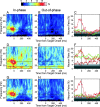Coherent oscillations in neuronal activity of the supplementary motor area during a visuomotor task
- PMID: 12890774
- PMCID: PMC6740733
- DOI: 10.1523/JNEUROSCI.23-17-06798.2003
Coherent oscillations in neuronal activity of the supplementary motor area during a visuomotor task
Abstract
Neural activity recorded in behaving animals is nonstationary, making it difficult to determine factors influencing its temporal patterns. In the present study, rhesus monkeys were trained to produce a series of visually guided hand movements according to the changes in target locations, and multichannel single-neuron activity was recorded from the caudal supplementary motor area. Coherent oscillations in neural activity were analyzed using the wavelet cross-spectrum, and its statistical significance was evaluated using various methods based on surrogate spike trains and trial shuffling. A population-averaged wavelet cross-spectrum displayed a strong tendency for oscillatory activity in the gamma frequency range (30 approximately 50 Hz) to synchronize immediately before and after the onset of movement target. The duration of synchronized oscillations in the gamma frequency range increased when the onset of the next target was delayed. In addition, analysis of individual neuron pairs revealed that many neuron pairs also displayed coherent oscillations in the beta frequency range (15-30 Hz). Coherent beta frequency oscillations were less likely to be synchronized than gamma frequency oscillations, consistent with the fact that coherent beta frequency oscillations were not clearly seen in the population-averaged cross-spectrum. For a given neuron pair, the time course and phase of coherent oscillations were often similar across different movements. These results are consistent with the proposal that synchronized oscillations in the gamma frequency range might be related to the anticipation of behaviorally relevant events and the contextual control of cortical information flow.
Figures









Similar articles
-
Behavioral context and coherent oscillations in the supplementary motor area.J Neurosci. 2004 May 5;24(18):4453-9. doi: 10.1523/JNEUROSCI.0047-04.2004. J Neurosci. 2004. PMID: 15128859 Free PMC article.
-
Analysis of phase-locked oscillations in multi-channel single-unit spike activity with wavelet cross-spectrum.J Neurosci Methods. 2002 Mar 30;115(1):67-75. doi: 10.1016/s0165-0270(02)00002-x. J Neurosci Methods. 2002. PMID: 11897365
-
Fast gamma oscillations in areas MT and MST occur during visual stimulation, but not during visually guided manual tracking.Exp Brain Res. 2002 Dec;147(3):360-73. doi: 10.1007/s00221-002-1252-0. Epub 2002 Oct 10. Exp Brain Res. 2002. PMID: 12428144
-
Phase correlation among rhythms present at different frequencies: spectral methods, application to microelectrode recordings from visual cortex and functional implications.Int J Psychophysiol. 1997 Jun;26(1-3):171-89. doi: 10.1016/s0167-8760(97)00763-0. Int J Psychophysiol. 1997. PMID: 9203002 Review.
-
The Control of Movements via Motor Gamma Oscillations.Front Hum Neurosci. 2022 Jan 17;15:787157. doi: 10.3389/fnhum.2021.787157. eCollection 2021. Front Hum Neurosci. 2022. PMID: 35111006 Free PMC article. Review.
Cited by
-
Triphasic dynamics of stimulus-dependent information flow between single neurons in macaque inferior temporal cortex.J Neurosci. 2010 Aug 4;30(31):10407-21. doi: 10.1523/JNEUROSCI.0135-10.2010. J Neurosci. 2010. PMID: 20685983 Free PMC article.
-
Behavioral context and coherent oscillations in the supplementary motor area.J Neurosci. 2004 May 5;24(18):4453-9. doi: 10.1523/JNEUROSCI.0047-04.2004. J Neurosci. 2004. PMID: 15128859 Free PMC article.
-
Brain responses to success and failure: Direct recordings from human cerebral cortex.Hum Brain Mapp. 2010 Aug;31(8):1217-32. doi: 10.1002/hbm.20930. Hum Brain Mapp. 2010. PMID: 20120013 Free PMC article.
-
Delayed synchronization of activity in cortex and subthalamic nucleus following cortical stimulation in the rat.J Physiol. 2006 Aug 1;574(Pt 3):929-46. doi: 10.1113/jphysiol.2006.110379. Epub 2006 May 18. J Physiol. 2006. PMID: 16709634 Free PMC article.
-
Neural noise and movement-related codes in the macaque supplementary motor area.J Neurosci. 2003 Aug 20;23(20):7630-41. doi: 10.1523/JNEUROSCI.23-20-07630.2003. J Neurosci. 2003. PMID: 12930802 Free PMC article.
References
-
- Aertsen AMHJ, Gerstein GL, Habib MK, Palm G ( 1989) Dynamics of neuronal firing correlation: modulation of “effective connectivity.” J Neurophysiol 61: 900-917. - PubMed
-
- Andrew C, Pfurtscheller G ( 1996) Event-related coherence as a tool for studying dynamic interaction of brain regions. Electroencephalogr Clin Neurophysiol 98: 144-148. - PubMed
-
- Aoki F, Fetz EE, Shupe L, Lettich E, Ojemann GA ( 1999) Increased gamma-range activity in human sensorimotor cortex during performance of visuomotor task. Clin Neurophysiol 110: 524-537. - PubMed
-
- Baker SN, Lemon RN ( 2000) Precise spatiotemporal repeating patterns in monkey primary and supplementary motor areas occur at chance levels. J Neurophysiol 84: 1770-1780. - PubMed
-
- Baker SN, Spinks R, Jackson A, Lemon RN ( 2001) Synchronization in monkey motor cortex during a precision grip task. I. Task-dependent modulation in single-unit synchrony. J Neurophysiol 85: 869-885. - PubMed
Publication types
MeSH terms
Grants and funding
LinkOut - more resources
Full Text Sources
Other Literature Sources
